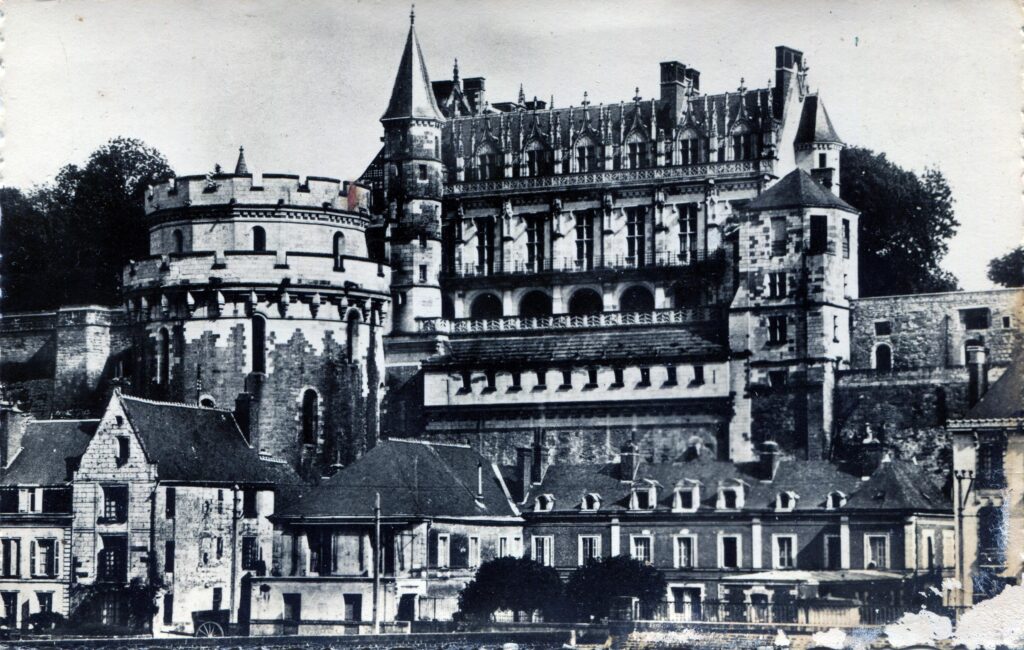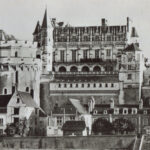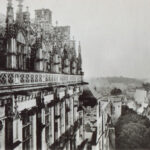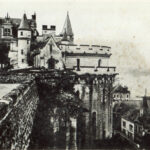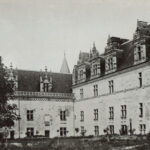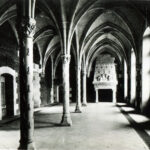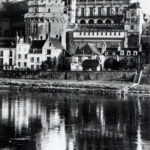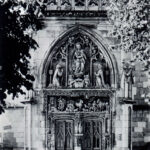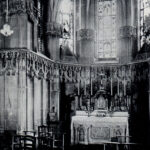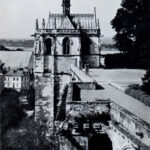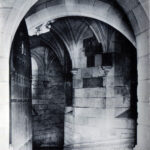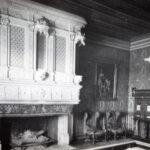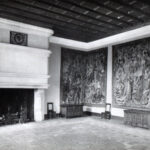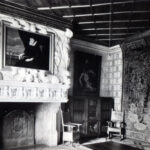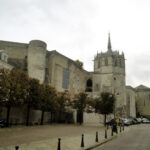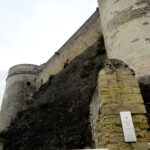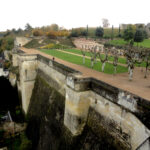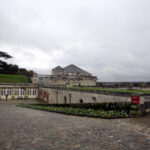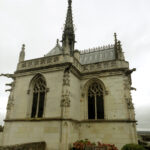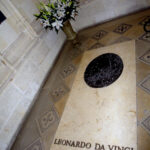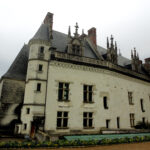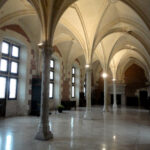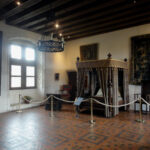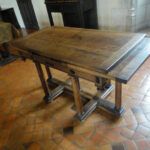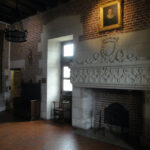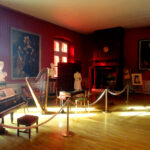Travel Guide Book to the Loire Valley, the most famous and unusual castles.
Royal Castle of Amboise, history and guide book.
See on the Loire Valley map – Château d’Amboise.
Amboise is a commune in the Indre-et-Loire department in central France, about 2-3 hours by high-speed train or car from Paris. It is located on the banks of the Loire River, 27 km east of Tours. Today it is a small trading house, once it was the House of the French royal court. The city of Amboise is located just 18 kilometers from the historic castle of Chenonceau, located on the Cher river, not far from the small village of Chenonceau. The city is famous for the Clos Lucé mansion where Leonardo da Vinci lived (and eventually died) at the invitation of King Francis I of France, whose Château de Amboise, overlooking the city, is only 500m away. examples of the wooden houses.
Other tourist attractions in the area.
– Just outside the city is the Pagoda de Chanteloup, a Chinese pagoda 44 meters high, built in 1775 by the Duke of Choiseul (Choiseul). The pagoda has seven levels in height, each slightly smaller than the previous one. An internal staircase leading to all levels is open to the public.
– The Musée de la Poste (in the Hotel Joyeuse) is a museum dedicated to the history of the postal delivery service.
A 20th-century fountain by Max Ernst stands opposite the market.
Brief history. Clovis I (c. 466–511) and the Visigoths signed a peace treaty of alliance with the Arvernians in 503, which helped him defeat the Visigothic kingdom at the Battle of Vouille in 507.
Jean d’Arc passed through the town in 1429 on her way to Orléans for the Battle of Patai.
The Château du Clos Lucé was the residence of Leonardo da Vinci between 1516 and his death in 1519. Leonardo died in the arms of King Francis I and he was buried in a crypt near the Château d’Amboise. The house has lost some of its original parts, but it still stands today, home to a museum of Leonardo’s works and inventions, and a beautiful view of the Loire River from its windows.
The Amboise Conspiracy was a 1560 conspiracy by Condé and the Huguenots against Francis II, Catherine de’ Medici and the Guises.
The castle was home to Mary Queen of Scots for most of her early life, who grew up here in the French court of Henry II. She arrived in France from Scotland in 1548, at the age of six, via the French king’s favorite palace at Saint Germain en Laye near Paris and remained in France until 1561 when she returned to their homeland, sailing down the Firth of Forth to Edinburgh on the 15th of August of that year.
The Edict of Amboise (1563) granted Protestants the right to worship freely.
Louis Claude de Saint-Martin, a French philosopher known as “Le Philosophe Inconnu” (“The Unknown Philosopher”, died in 1803), was born here in 1743.
Abd el Kader ibn Mouhi Ad-Din (Abd el Kader Ibn Mouhi Ad-Din, circa 1807-1883) was imprisoned at the Château d’Amboise.
The Second World War: the German military units were located, the anti-aircraft guns are visible in the photo.
During 2019, the year of the 500th anniversary of da Vinci’s death, Amboise held many events commemorating the life of the master and his work completed in the city. For example, the number of visitors to the Château du Clos Lucé in 2019 was estimated at 500,000 people, which is 30% more than usual.
- Amboise castle, Loire Valley
- Photo N3
- Photo N4
- N5
- N6
- N7
- Chapel (N8)
- Stained glass windows and the tomb of Leonardo da Vinci
- Exterior view of the chapel from the tower (10)
- Entrance for knights on horseback (14)
- Fireplace and furniture, wooden cabinet, artistic carving (12)
- Carpets, tapestries (11)
- Oil painting and chairs (13)
Guide – and description of the Amboise castle
The castle of Amboise, confiscated by the monarchy in the 15th century, became a favorite royal residence and was carefully rebuilt. King Charles VIII died at the castle in 1498 after hitting his head on a door lintel. From the second half of the 16th century, the castle fell into disrepair, and most of the internal buildings were later demolished, but some survived and were restored along with the outer defensive ring of towers and walls. The French Ministry of Culture has recognized it as a historical monument since 1840.
The castle was built on a spur of the Loire River and is located at an altitude of 81 meters. The strategic qualities of this place were recognized even before the medieval construction of the castle, and the Gallic oppidum was built here. At the end of the 9th century, Ingelgarius became viscount of Orléans and, through his mother, was associated with Hugh Abbot, tutors of the French kings. Ingelgarius married Adelais, a member of a prominent family (the bishop and archbishop were her uncles) who controlled Amboise. He was later made Count of the Angevins and his rise can be attributed to his political connections and reputation as a warrior. Amboise Castle passed through the heirs of Ingelgarius and Adelais, and went to their son Fulk the Red. As Fulk the Red expanded his territory, Amboise, Loches and Villetrois formed the core of his domain. Amboise lay on the eastern border of the Angevin possessions.
Amboise and his castle passed through the family to Fulk Nerre in 987. Fulk had to contend with the ambitions of Odo I, Count of Blois, who wanted to expand his territory to Anjou. Odo I was able to enlist the support of many followers and instructed Conan, Count of Rennes, Gelduin of Somre and Abbot Robert Saint-Florent de Saumur to harass Fulk’s domain. While Conan was busy on the western border of Anjou, Gelduin and Robert attempted to isolate the easternmost castles of Amboise and Loches by raiding the lands of Saumur and disrupting communications. To further threaten Amboise, fortifications were erected at Chaumont and Montsoreau while Saint-Aignan was garrisoned.
Royal residence. Expanding and improving over time, it was captured by Charles VII of France on 4 September 1434 after its owner, Louis d’Amboise, Viscount of Tours (1392–1469), was convicted of plotting against Louis XI and sentenced to death in 1431 However, the king forgave him, but took his castle in Amboise. Once in royal hands, the castle became a favorite of French kings, from Louis XI to Francis I. Charles VIII decided to rebuild it thoroughly, starting in 1492, first in the French late Gothic style, and then after 1495, hiring two Italian masons, Domenico da Cortona (Domenico da Cortona) and Fra Giocondo (Fra Giocondo), who provided in Amboise some of the first noticed decorative Renaissance motifs in French architecture. The names of three French builders are preserved in the documents: Colin Biart, Guillaume Senault and Louis Armangeart.
After the Italian War of 1494–1495, Charles (Charles) brought Italian architects and artisans to France to work on the castle and turn it into “the first Italian palace in France”. Among the people whom Charles brought from Italy was Pacello da Mercogliano, who designed the gardens at the castles of Amboise and Blois; his work had a great influence on French landscape designers. Charles died at the Château d’Amboise in 1498 after hitting his head on a door lintel. Before his death, he expanded the upper terrace to accommodate a larger parterre, and enclosed it with bars and pavilions; his successor Louis XII built a gallery around the terrace, which can be seen in the 1576 engraving by Jacques Androuet du Cerceau in “Les plus excellens bastimens de France”. The parterres were recreated in the twentieth century as rectangles of gravel lawns and a formal bush of trees.
King Francis I grew up in Amboise, which belonged to his mother, Louise of Savoy, and during the first few years of his reign, the castle reached the height of its glory. Leonardo da Vinci, as a guest of the king, came to Château Amboise in December 1515 and lived and worked in the nearby Clos Luce, connected to the castle by an underground passage. Records show that at the time of Leonardo da Vinci’s death on May 2, 1519, he was buried in St. Florentine Chapel, originally located (before it was demolished at the end of the 18th century) about 100 meters northeast of St. Guber. This Saint Florentine chapel belonged to the royal castle and was located within the stone fortifications surrounding the Château d’Amboise property, and should not be confused with the nearby Église Saint Florentin, also in Amboise, but not located within the Château d’Amboise property.
After the French Revolution (1789–1799), Saint Florentine’s chapel was in such a state of disrepair that an engineer appointed by Napoleon decided it was not worth saving and had it demolished. The remaining stonework was used to repair the castle. About sixty years later (and 330 years after Leonardo’s death and initial burial) the fundamental site of the Chapel of St. Florentine was excavated: it is claimed that a complete skeleton was found with fragments of a stone inscription containing some of the letters of his name. However, other accounts describe piles of bones (as is common in chapels throughout France) and even anecdotes about children kicking skulls for fun and games. However, according to some evidence from the time, this collection of bones, which turned out to be intact and with an unusually large skull, was supposedly buried in the chapel of St. Huber, where there is now a large marble stone at floor level depicting a metal medallion with a relief portrait of Leonardo da Vinci (based on the “portrait of Melzi”) and the words of LEONARDO da Vinci seem to indicate his final resting place.
Henry II and his wife Catherine de Medici raised their children at Amboise Castle with Mary Stuart, the infant Queen of Scots, who was promised to marry the future Francis II of France.
Conspiracy. In 1560, during the French Wars of Religion, a plot by members of the House of Bourbon Huguenots against the House of Guise, who effectively ruled France in the name of the young Francis II, was uncovered by the Comte de Guise and put down by a series of attacks and hangings that took a month to complete. By the time it was completed, 1,200 Protestants had been hung from the walls of the city, from the iron hooks that held pennants and tapestries on feast days, and from the Logis du Roy balcony itself. The court soon had to leave the city due to the smell of corpses.
The failed Treaty of Amboise was signed at Amboise on March 12, 1563 between Louis I de Bourbon, Prince de Conde, who was involved in a plot to kidnap the king, and Catherine de Medici. The “Decree of Appeasement,” as it was called, allowed Protestant services only in the chapels of seigneurs and judges, with the condition that such services should be held outside the city walls. This compromise did not satisfy either side, and it was not widely accepted.
The decline. Amboise never returned to royal favor. At the beginning of the 17th century, the huge castle was almost abandoned when its possession passed into the hands of Gaston d’Orleans, brother of the Bourbon king Louis XIII. After his death, it returned to the crown and was turned into a prison during the Fronde, and under Louis XIV of France it housed the disgraced minister Nicolas Fouquet and the Duc de Lauzin. Louis XV gave it to his minister, the Duke de Choiseul, who had recently bought the Château de Chanteloup to the west. During the French Revolution, most of the castle was demolished, much damage was done, and an engineering assessment commissioned by Emperor Napoleon Bonaparte in the early 19th century resulted in most of the castle having to be repaired or demolished.
Since 1840, the Amboise castle has been listed as a historical monument by the French Ministry of Culture. King Louis Philippe began to restore it during his reign, but after his abdication in 1848, the castle was confiscated by the government. The captive Emir Abd al-Qadir, who resisted the French colonization of Algeria, as well as his family and associates, were transferred to Château d’Amboise in November 1848.
Later that year, in October, President Louis-Napoleon Bonaparte visited Abd al-Qadir in Amboise to inform him of his release. In 1873 Louis Philippe’s heirs gained control of the property and under the direction of Eugene Viollet-le-Duc a major effort was made to renovate it.
WW2 and Amboise Castle. During the German invasion in 1940, the castle was further damaged. The terraces of the castle occupy a dominant position in the area, so German anti-aircraft batteries were installed here. The anti-aircraft batteries were a legitimate target for Allied air attacks, which also caused some destruction.
Today, the current Comte de Paris, a descendant of Louis Philippe, renovates and maintains the castle through the Fondation Saint-Louis.
Virtual tour, the old and modern views.
Kingdom at the beginning of the reign of Charles VIII. Military campaigns of the King of France in Italy and the arrival of the first Italians in Amboise.
On the terraces. Erto tower. Chapel of Saint Hubert and the burial place of Leonardo da Vinci. Stained glass. Backyard and moat in front of the royal palace.
- Entrance to the Château d’Amboise castle
- Huge high walls and towers
- Landscaped gardens on the terraces of the castl
- Terrace and Erto Tower
- Chapel of St. Hubert and the tomb of Leonardo da Vinci
- Tomb of Leonardo da Vinci
- Royal Palace Wing
- Council Hall and fireplaces
- Tapestries, bed and furniture of King Henry
- Wine-drinking hall, simple Italian tables, the fashion of the time
- Rope room, armchairs and portraits
- Music salon, instruments
Gothic palace. Entrance, guardroom and gallery (observation point). Room of the guard of honor and tambourines. Annexation of Brittany.
Council Hall. Francis I (1494 -1547), patron of the arts of the Renaissance. The Amboise conspiracy and the background of the Wars of Religion.
Chambers of the Renaissance: The butler’s hall. Bedchamber of Henry II. Rope front and the Order of the Archangel Michael.
The vicissitudes of fate, the monarchs and the move to Ile-de-France.
Chambers of the Dukes of Orleans. Study and bedchamber of the Dukes of Orleans-Pientevre. Louis-Philippe, Music Salon, Emir Abd-al-Qadir.
Minim tower Ramp for riders and Omal Gallery.
Neapolitan terrace, reminiscent of the renaissance. Upper terrace of hornbeam alleys. landscaped gardens. Leonardo da Vinci and the castle. Monument, burial and workshops located in the vicinity.
Opening hours of the castle for visitors. Open to visitors throughout the year except January 1st and December 25th.
How to visit by yourself or book a private sightseeing tour.
- Loire Valley Private Tours from Paris or Charles de Gaulle Airport with 3 Castles in One Day Sightseeing trip by a car with a English speaking guide.
WW2 battlefield tours and Amboise Castle
As it was written above, during the Second World War, the terraces of the Amboise castle were used as the location of German anti-aircraft installations. Thus, the engineering architecture of the Middle Ages was used in the Second World War. During specialized tours of the battlefields in the Loire Valley with a visit to the tank museum in Saumur or the Military Engineers in Angers, the royal castle of Amboise can be included in the itinerary.

